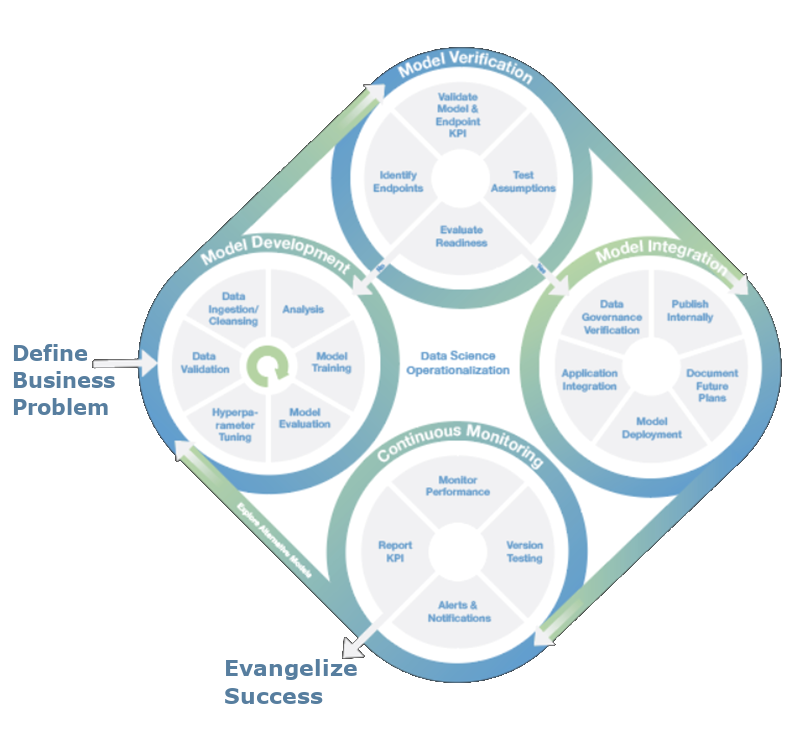Solution Offering
Data Science Operationalization
As data science becomes more mature in an organization, teams move from creating machine learning models in isolation to establishing processes that integrate these models throughout the company’s larger ecosystem. Data Science Operationalization, also known as MLOps, involves linking four critical processes throughout the organization: Model Development, Model Verification, Model Integration and Continuous Monitoring.
The path to data science operationalization can be complex. The process involves aligning the needs and skillsets across teams such as data science, data engineering, data governance and executive stakeholders. There is also a multitude of technologies that can be leveraged to support continuous model integration and deployment. At eSage Group, we leverage our technical expertise and soft skills to help clients establish this process successfully in the organization.
Model Development
In Model Development, data scientists are primarily concerned with finding the best predictive model for a well-defined business problem. They explore the data, cleanse it, craft features that have potential to explain the data, choose algorithms, optimize them, and attempt to create high performing models that generalize to real-world settings. In this phase, data scientists often work on local machines with sample data, leveraging tools such as Jupyter Notebooks and programming languages such as Python or R to develop and optimize models. For big data, these same tools can be leveraged on cloud instances, but setting this up requires some data engineering experience. If you do not have this experience, data scientists need to work closely with their data engineering team, or an external MLOps integration partner such as eSage Group.
Model Verification
During Model Verification, data scientists and data engineers will partner to test how well the model generalizes to real world conditions. The goal is to set up deployment endpoints, test the model among a sample of users (Canary Deployments or A/B testing, etc.) and validate that the model will improve KPIs for the business. Every day seems to bring a new tool to the market to help optimize this process. Depending on your team’s data infrastructure, you might leverage AWS SageMaker, MLFlow, Azure Machine Learning or many other tools to accomplish this goal.
But what’s best for each organization depends on both internal skill sets, existing technologies and budgets for consultants that can help with data integration.
Model Integration
Once we’ve tested the model and have determined that it’s ready for deployment, Model Integration ensures that that the model will be managed at a higher level. Processes need to be in place to confirm that the model meets corporate governance and compliance criteria (personally identifiable information, etc.). Data governance becomes increasingly critical as the number of models grows and they need to be cataloged and managed for updates. The model needs to be published to a repository. Teams will indicate the types of updates that should be explored for future versions and recommend a frequency for updates.
While conceptually everyone may know what they need, technically, teams often need help implementing a workflow that follows CI/CD best practices for updating models. This entire process requires coordination and tools to manage the model lifecycle to achieve goals without interrupting critical business operations.
Continuous Monitoring
Even the best machine learning model will lose its relevance over time as consumers and market conditions change. Therefore, systems should be put in place to counteract model drift. Continuous Monitoring handles this process. Teams enable robust dashboards to help monitor KPI’s across a range of models and set up alerts for when models fall below specified targets. This process helps keep models healthy and also indicates when models are ready for an update.
For more insight into model drift, check out our team’s recent blog post, Detect and Defend Against Machine Learning Drift.
Our team at eSage Group helps clients establish these foundational practices. We enable processes for models to flow seamlessly throughout the organization, supporting continuous optimization and business efficiency. Contact our team to discuss options for optimizing your data science ecosystem. info@esagegroup.com.

